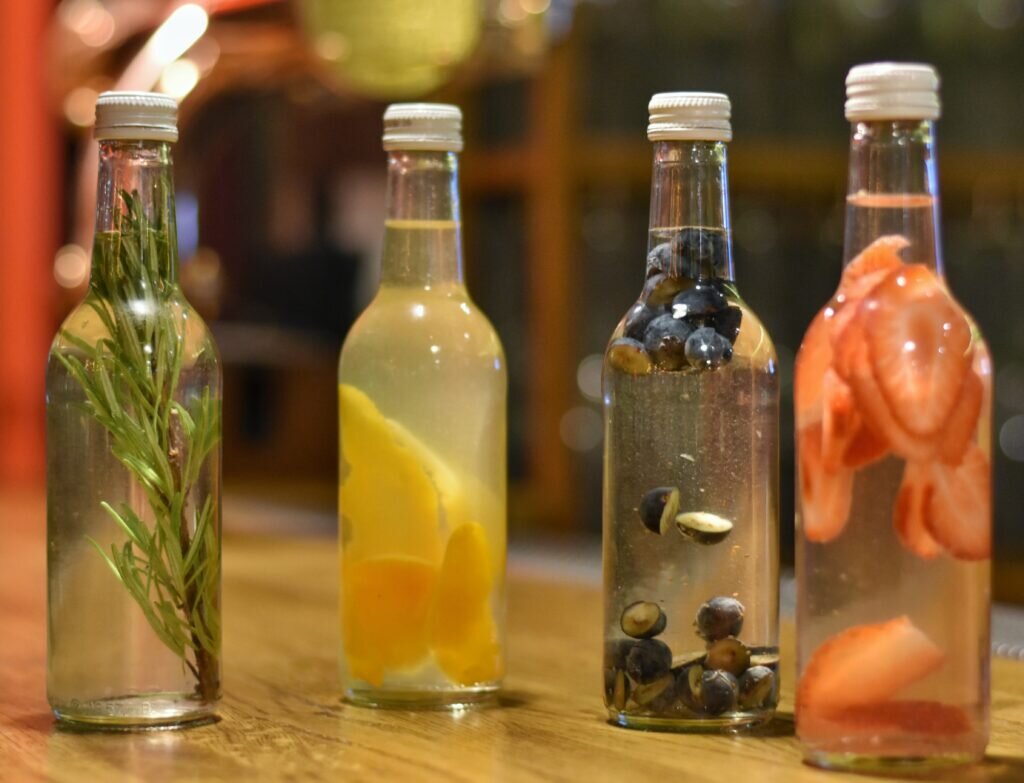How to infuse spirits at home
Making homemade flavoured spirits is easily done at home with nothing more then your spirit of choice, be it vodka, gin, whisky or tequila, a jar and some chosen ingredients. Learn all about infusing spirits through maceration below.
There are many ways to infuse alcohol. You could flash infuse them, fat wash them, distil them or steep them. Steeping spirits for infusion is also known as maceration.
The most popular technique is happens to be maceration, which is also the technique you can do at home. Maceration is where you steep an ingredient you want to infuse in alcohol and then let it sit for a couple of hours, days or weeks depending on the ingredient and shaking periodically. It’s the easiest technique and the cheapest way to infuse a spirit.
Side note: If you’re wanting to infuse a single spirit with multiple flavours i.e. Pineapple and mint rum, then check use the Smartblend flavour guide to find complimentary flavour inspiration and ideas.
How To Infuse Spirits With Maceration
This technique couldn’t be any easier. You take the spirit you want to infuse, pour it in a sealable jar and add whatever it is you want to infuse it with. Leave it in a cool dark place, shake it periodically, and eventually, the spirit will draw out the flavours and viola! You have an infused, homemade, flavoured spirit.
The difficulty comes with the variations of steeping timing depending on the ingredients you’re using. As well as how you macerate that ingredient.
You want to get the best infusion you can. if you’re trying to say, make an orange vodka, then you need to decide what part of the orange you will use. I mean sure, the peel is the obvious choice, but using the peels alone might end with more of a perfumed orange taste rather than a natural one, and leaving the pith in with the infusion, which is the white bit between the peel and orange flash will quickly turn your infusion bitter.
A lot of creating the perfect infusion just comes down to trial and error.
Anytime I'm trying a new infusion that I haven't done before, I spread it out over a few jars. Let's say I'm trying my hand at a grapefruit vodka. Then instead of pouring a full 700ml bottle of vodka into a large jar with my grapefruit peels, I’ll split that 700ml bottle of vodka equally in 4 or so smaller jars.
In one jar I'll add fresh grapefruit peels, the pith and all, in another I’ll add dehydrated grapefruit peels, in another I'll add dehydrated grapefruit wheels, and in the last I'll add fresh grapefruit wedges. I’ll then label the jars and taste test them everyday.
Once I feel they are at their optimal infusion (which is all personal preference) I will strain them out and see which I prefer. I might even blend a few together. When I did try this I ended up blending 20% of the grapefruit vodka with fresh peels, and 80% of the grapefruit vodka with dehydrated wheels. Each one had subtle differences from bitterness to freshness. Blending them together is like a cocktail of its own.
However, when it comes to blending. The flavour you get at the start might not be the flavour your infusion ends up taking on. As the blend ages new flavours appear and others may become subtle. So I then let that infusion sit in a new jar for a further week before I bottle it so the 2 flavours have time to mature, or as the spice girls would say, for the two to become one.
It’s a delicate balance between science and intuition.
But don’t get ahead of yourself. If it’s your first time infusing spirits then don’t take it too seriously or bother yourself with multiple infusions and blending. Stick to one jar and keep tasting it until it suits your own flavour preferences.
The Science of Macerating Alcohol to Infuse
I’m no scientist. Let's just start with that, but I have had plenty of experience infusing a spirit or two. When it comes to the science of spirit maceration there are two processes which occur. These processes are what make that infusion happen.
The processes I’m speaking of are Osmosis and Dissolution. These processes explain a lot, including why I find it preferable to mix both dried fruits and fresh fruits to create my infusions. And why it could be beneficial for you to do the same. But what the hell is Osmosis and Dissolution?
Osmosis
Basically, fresh ingredients like fruits and vegetables contain a lot of water. Osmosis is when you’re steeping different ingredients in liquid and that water from the fruit/vegetable flows naturally to an ingredient which has less water to even things out and reach the equilibrium. It’s nature striving for balance. As the fruit flavour water flows throughout the alcohol the flavour of said fruit clings to the alcohol and you get a flavoured spirit.
Dissolution
Dissolution happens with dried flavourings and is where there is no water to be exchanged by osmosis. So the process is about releasing and dissolving compounds into the alcohol. for this method, the higher the alcohol, the more effective the infusion as the alcohol will break down the dried fruits, herbs or other botanicals and pick up the flavours.
Motion, heat and pressure
Motion, heat and pressure are the three key techniques to getting the best results from your maceration. Maceration isn’t just a home technique for flavouring spirits - It’s what the big dog gin and liqueur companies do But how can you utilize these key elements at home on a smaller scale?...
Motion, heat and pressure can be used to increase the rate of extraction. Motion is as simple as shaking a jar in which something is being infused every few hours or days.
Of course, big Gin distilleries and liqueur companies are not using small bottles to infuse their neutral spirit, they will have large revolving tanks able to utilize motion..
Pressure forces the alcohol into the botanical’s being infused. This method extracts both flavour and colour. At home, pressure is something we also use when shaking the jar.
Heating helps break open the botanical’s cells, allowing the alcohol to extract the flavours more easily. The big dog gin and liqueur companies will have pressurised, revolving and temperature controlled tanks. The way we at home use heat is by simply storing our infusion in a cool dark place.
Multiple Spirit Infusion
Before we move on to some simple flavoured spirit recipes let's just cover another technique in steeping spirits which is multiple infusion, and the two ways you can do this.
What I mean by multiple spirit infusion is one liquid which is a blend of different flavours i.e. orange and mango vodka, cinnamon and vanilla rum or rosemary, orange, mint and star anise infused gin.
There are two ways you can do this. The first way is to simply dump all your ingredients in one jar and let them naturally blend and infuse. Everyday you will taste the spirit and if you seem to be getting one overpowering ingredient simply take it out and continue the infusion.
The second method is to split the infusion up and blend them together at the end.
Example: You’re making a strawberry and mint gin - Split a 700ml bottle of gin between two jars, in one jar add the mint and in the other add the strawberry. After one week start daily tasting, once one is ready, strain it out and let it sit in the jar until the other is ready. Once both are fully infused to your liking then blend them together in a way that suits you.
For this example, Mint works best as a supporting flavour, so we may blend the two at 80% strawberry infused gin and 20% mint infused gin. Let that new blend sit in a jar for 1 week, taste and adjust as necessary then bottle it up ready for use!
Basic spirit infusion recipes
How To Make Vanilla Vodka
Ingredients
1 Vanilla bean
1 700ml bottle of vodka
Method
1) Cut one vanilla bean length ways to release the beans
2) Add the whole thing to a jar and pour in 700ML of Vodka
3) Seal and store in a dark cool place, shaking periodically one shake a day will be enough
4) Allow to infuse for 1-2 Weeks then strain into a bottle
How To Make Spiced Rum
Ingredients
1 Vanilla bean
1 Cinnamon stick
The peels of 1 orange
3 Star anise
3 Clove
1 700ml bottle of dark rum
Method
1) Cut the vanilla bean length ways to release the beans
2) Add the whole vanilla bean to a jar with the cinnamon stick, orange peels, star anise and clove.
3) Pour in 700ML of Dark Rum
4) Seal and store in a dark cool place, shaking periodically
5) Allow to infuse for 1-5 Days, Shaking and tasting everyday. Strain out all the spices apart from the vanilla bean, allow to infuse for a further 7 days then strain out the vanilla bean and bottle.
Infusion Tips:
Use this flavour guide to find complimentary flavours for infusing two or more ingredients.
If you can get your hands on some. Higher proof alcohol will make for better infusion, afterwards you can dilute it to a drinkable strength of about 40% (with some maths)
If you infuse with 80% Alcohol, not only will the infusion be quicker but the alcohol will be able to break down and infuse more deeper, complex flavours. After you bottle it, it will taste very strong but don’t worry! If you have 700ml of spirit infusion, mix it with 700ml of water and let it sit for a week. The ABV will come down to a drinkable 40% ABV which will allow the flavour to really pop!
The maths: 700ml of liquid which is 80%. I want to half that ABV to 40%, so simply by doubling the volume of liquid with non alcoholic liquid (water) the ABV for the new 1400ml of water will be half the original ABV strength. Equalling 40% ABV.
If that doesn’t make sense then don’t worry. Googling a ABV dilution calculator will help you a lot.
Separate different variables of the same infusions, then blend them once done as I describe in the above “how to infuse” section. It means you will have more control over the end flavour.
Dark, cool areas work best for the infusion process. somewhere like a cupboard, or on a high shelf.









